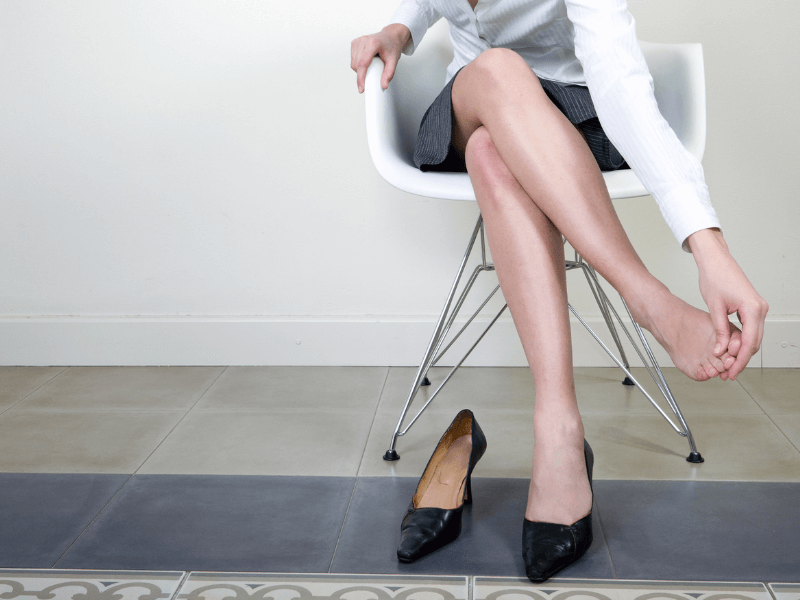Corns and calluses are two of the most common foot complaints, yet many people confuse the two. While both involve a buildup of thickened skin, they differ in their appearance, cause, and the discomfort they bring.
If you’re struggling with painful or unsightly patches of hard skin, understanding the difference between corns and calluses—and how to treat them—can make a big difference to your comfort and mobility.
What’s the Difference Between Corns and Calluses?
Though related, corns and calluses are distinct in shape, location, and sensitivity.
Corns:
- Small, circular, and concentrated areas of thickened skin
- Often form on toe joints, tops, sides, or between toes
- Can be hard (with a dense core), soft (waxy between toes), or seed corns (tiny, painful spots on the ball of the foot)
- Usually painful when pressed or walked on
- If untreated, can become inflamed or infected, sometimes leaking pus or fluid
Calluses:
- Wider, flatter patches of thickened skin
- Commonly appear on heels, balls of the feet, or sides of the foot
- Typically yellowish and rough to the touch
- Less painful than corns but can become uncomfortable or crack if allowed to build up
Note: Corns are more likely to cause sharp, localised pain, while calluses feel more like general pressure or burning discomfort.
What Causes Corns and Calluses?
Both corns and calluses develop in response to repeated pressure or friction on the skin. Your body produces extra layers of skin in an attempt to protect vulnerable areas—but over time, this can cause pain and structural changes to the foot.
Common causes include:
- Ill-fitting footwear, especially narrow shoes or high heels
- Toe deformities such as hammertoe or bunions
- Walking barefoot or in unsupportive shoes
- Excessive walking or standing
- Wearing shoes without socks, or socks that bunch or tighten
- Age-related changes like thinning skin or reduced fat padding
A study in the Journal of the American Podiatric Medical Association found that women are more susceptible to developing calluses, largely due to tight or heeled footwear.
How to Prevent Corns and Calluses
Prevention is always better than cure. Most corns and calluses can be avoided by making small, consistent changes to your foot care routine.
1. Choose Properly Fitting Footwear
- Have your feet measured regularly, especially if you’re buying shoes online
- Shop for shoes in the afternoon when your feet are naturally more swollen
- Ensure there’s room at the toes and that shoes aren’t too tight across the ball of the foot
- Avoid high heels or pointy shoes where possible
2. Wear the Right Socks
- Choose well-fitting, cushioned socks that don’t slide or rub
- Avoid socks that are too tight or cause pressure at the toes
- Always wear socks with closed shoes to reduce friction
3. Address Foot Structure Issues Early
If you have flat feet, bunions, or toe deformities, see a podiatrist to explore:
- Custom orthotics to rebalance foot pressure
- Protective padding or toe spacers
- Advice on the best shoes for your foot shape
4. Moisturise Daily
Dry skin is more prone to cracking and hardening. Use a foot-specific moisturiser with urea or lactic acid to keep skin soft and flexible.
How to Treat Corns and Calluses at Home
For minor cases, these simple home treatments may help:
- Soak your feet in warm, soapy water for 10–15 minutes to soften skin
- Gently file thickened areas using a pumice stone or foot file (avoid over-filing)
- Apply moisturiser after drying, ideally a foot cream with urea or salicylic acid
- Use protective pads or insoles to relieve pressure on the affected areas
- Switch to more comfortable footwear immediately
Avoid using corn plasters with salicylic acid if you have diabetes or poor circulation. These can damage healthy skin and cause ulcers.
When to See a Podiatrist
Home care isn’t always enough. You should book a professional assessment if:
- The corn or callus is painful, red, swollen, or leaking fluid
- You have an underlying health condition such as diabetes, neuropathy, or poor circulation
- You’re unsure whether the hard skin is a corn, callus, or wart
- The problem keeps coming back despite your best efforts
At Feet By Pody, our podiatrists can:
- Safely remove corns and calluses painlessly with specialist tools
- Assess the underlying cause, such as foot structure or pressure points
- Create custom orthotics to redistribute weight
- Offer advice on footwear, padding, and skin care routines
- Treat complications like infections, ulcers, or cracked heels
Long-Term Foot Health Matters
Untreated corns and calluses can lead to:
- Ongoing foot pain
- Postural issues and compensatory walking habits
- Skin infections
- Ulcers in high-risk patients
Routine foot care and early intervention help prevent more serious problems and keep you comfortably on your feet.
Book a Corn or Callus Treatment Today
If you’re suffering from painful corns, uncomfortable calluses, or hard skin that won’t go away, our expert podiatrists are here to help.
Contact Feet By Pody on 0207 099 6657 or book a podiatry appointment online for safe, effective corn and callus removal at one of Feet By Pody’s London podiatry clinics.

